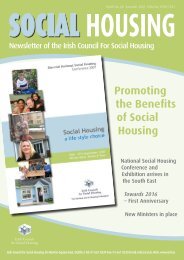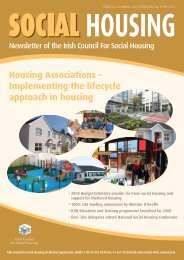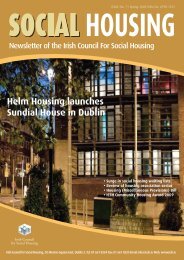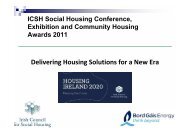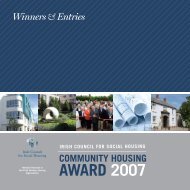National Housing Strategy for People with a Disability 2011 - 2016
National Housing Strategy for People with a Disability 2011 - 2016
National Housing Strategy for People with a Disability 2011 - 2016
You also want an ePaper? Increase the reach of your titles
YUMPU automatically turns print PDFs into web optimized ePapers that Google loves.
experience in dealing <strong>with</strong> housing authorities and lack of awareness of housing optionsavailable 111 .Tenant Rights10.20 This strategy recognises the importance of secure tenure and the rights of tenantsin their accommodation, irrespective of the housing provider. The Government is committedto the continued development of the voluntary & co-operative housing sector includingexpanding their role in social housing delivery, improving governance and achieving more<strong>for</strong>mal accountability generally in relation to the activities of the sector. The relationshipbetween tenants and housing bodies currently operates on the basis of lease agreementsand/or various Landlord and Tenants Acts. In view of the ongoing evolution of the sectorand its greater role in social housing provision, it is proposed to extend the remit of theResidential Tenancies Act 2004 to the voluntary and cooperative sector. However, segmentsof the voluntary sector, such as sheltered housing, may not be suitable <strong>for</strong> regulation underthis Act. The inclusion of the voluntary and cooperative sector under the ResidentialTenancies Act will enhance and improve their tenants’ rights and remove the current barrierwhich prevents both tenants and service providers accessing the services of the PrivateResidential Tenancies Board.10.21 The ICSH provides its members <strong>with</strong> a sample standard tenancy agreement andgives guidance on its application. It also recommends that members adopt a tenancyhandbook explaining the rights and responsibilities of tenants and the housing association ineasy to understand <strong>for</strong>mats such as through the use of symbols or easy read design. Agood example is the tenancy handbook produced by St. Michael’s House <strong>Housing</strong>Association <strong>for</strong> people <strong>with</strong> intellectual disabilities.Intellectual <strong>Disability</strong> and Dementia10.22 A further issue to be considered is the increased incidence of dementia amongstsome adults <strong>with</strong> intellectual disabilities. A recent review of literature 112 in this areaestablished that signs and behaviours associated <strong>with</strong> Alzheimer’s type dementia, amongstothers, emerge in adults <strong>with</strong> Down Syndrome at an earlier age than in the generalpopulation, in approximately one in three adults. In such cases, housing needs may changefollowing the onset of dementia and housing authorities and service providers must becognisant of the possibility of the need <strong>for</strong> increased care and provision of alternative <strong>for</strong>msof housing.111For these purposes an advocate may be a spouse, parent or relative; a guardian or a person acting as locoparentis; a legal representative or a personal advocate assigned by a Citizens In<strong>for</strong>mation Board to representthe person.112Dementia in older adults <strong>with</strong> intellectual disabilities, IASSID, Special Interest Research Group on Ageing andIntellectual Disabilities (March 2009)133



